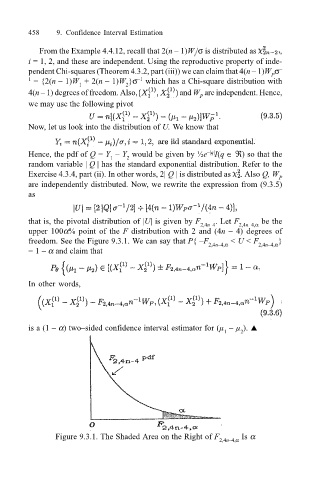Page 481 - Probability and Statistical Inference
P. 481
458 9. Confidence Interval Estimation
From the Example 4.4.12, recall that 2(n 1)W /σ is distributed as ,
i
i = 1, 2, and these are independent. Using the reproductive property of inde-
pendent Chi-squares (Theorem 4.3.2, part (iii)) we can claim that 4(n 1)W σ
P
1 = {2(n 1)W + 2(n 1)W }σ which has a Chi-square distribution with
1
1
2
4(n 1) degrees of freedom. Also, and W are independent. Hence,
P
we may use the following pivot
Now, let us look into the distribution of U. We know that
Hence, the pdf of Q = Y Y would be given by ½e I(q ∈ ℜ) so that the
|q|
1
2
random variable | Q | has the standard exponential distribution. Refer to the
Exercise 4.3.4, part (ii). In other words, 2| Q | is distributed as . Also Q, W P
are independently distributed. Now, we rewrite the expression from (9.3.5)
as
that is, the pivotal distribution of |U| is given by F 2,4n4 . Let F 2,4n4,α be the
upper 100α% point of the F distribution with 2 and (4n 4) degrees of
freedom. See the Figure 9.3.1. We can say that P{ F 2,4n4,α < U < F 2,4n4,α }
= 1 α and claim that
In other words,
is a (1 α) twosided confidence interval estimator for (µ µ ). !
1 2
Figure 9.3.1. The Shaded Area on the Right of F Is α
2,4n4,α

